In Search of Great Grandfather Cho
3
by Norman Cho
In 2011, I discovered the grave of my paternal grandfather, Cho Kim Leong at Bukit Brown Cemetery. Since then, I have been trying to locate the tomb of his father, Cho Boon Poo (Cho Poo), who was laid to rest in Malacca. I had absolutely no clue as to which cemetery he was buried. Bukit Cina and Jelutong cemeteries came to mind but these are huge cemeteries with more than a hundred thousand graves each. They are maintained by the Cheng Hoon Teng Temple but pre-war records are unavailable. It seemed that I had hit a dead-end!
However, miracles do happen. To me, these are little blessings from above. Perhaps, the old man had wanted his descendants to visit him and had influenced how things turned out. It must have been decades since the last time any descendants paid their respects at his tomb. He must have known my sincerity and had helped me along without my knowledge. The breakthrough came in April 2014. A relative whom I had never known, contacted me via Facebook to introduce himself as the maternal great-grandson of Cho Poo, after he had discovered that we have matching ancestors from an online Family Tree software on the internet. 70 year old Vincent Lee was descended from Cho Poo’s eldest son, Cho Kim Choon, while my paternal grandfather, Cho Kim Leong, was the third son. He resides in Australia and was planning a trip down to Singapore in April 2014. He requested my assistance to put him in touch with the relatives in Singapore.
It turned out to be a blessing for me! I talked to my eldest aunt, Rose Cho (88 years old), to ask for the contacts of other relatives from the Cho clan. That was how I found aunt Elizabeth Cho (62 years old), who was the only child from the fifth son, Cho Kim Hock, a famed state badminton player for Malacca in the 1930s. We organised a dinner for our overseas relative and his wife. During dinner, I had a nice chat with Elizabeth – whom the family affectionately calls Bert – about Cho Poo. She told me that her only visit to his grave was when she was a child of 9 years old. That was more than 50 years ago! Her father who was the only surviving son at that time dreamt of his father asking him why he had not visited him in such a long time. Heeding the call, he brought his wife and daughter to pay their respects to his father. Since then, he had visited the grave alone every year till several years before his death in 1990.
Aunt Elizabeth, had the memory of an elephant! She vividly recalled that the cemetery was about a 40-minutes-drive from the Malacca Town, but had no inkling about the name of the cemetery. She further described that the cemetery was sliced into two by the main road, there was a cemetery on the left and another on the right, and Cho Poo’s was on the right. The tomb was relatively large and on a gentle-sloping plain. It faced a vast and beautiful paddy field. She added that the cemetery was on the land which once belonged to Cho Poo and was probably the private burial ground of the Cho family. Later, when the family was not doing well financially, it was sold to the Malacca’s Eng Choon Hway Kwan and it became a cemetery for the Eng Choon community. She thinks that the tomb should still be there, given the leisurely pace of development in Malaysia. She asked if I would be able to find the tomb. I told her that I could try. All her clues were useful, except for the paddy field. I told her that I doubt the paddy field in her memory still exists. Nevertheless, I took whatever clues that I could use and converted them into intelligent information.
Firstly, I eliminated Bukit Cina as it was near Malacca Town and therefore could not be a 40-minutes-drive. Next, I looked at the map of Jelutong cemetery but it was not sliced into two by any road. I asked a few Malaccan friends of other lesser-known cemeteries and searched the Google Map for them. Finally, I found a relatively small cemetery, probably no larger than 20 acres, which was dissected by a main road. It was away from the Malacca Town and would probably take about 30 minutes to get there by car. This was the Krubong Cemetery. To be certain that I had located the correct cemetery, I contacted a Malaccan friend who verified that this cemetery is indeed managed and owned by the Eng Choon Hway Kwan. He helped me to obtain the mobile contact of the tomb-keeper to locate the grave. With modern technology, I communicated with the tomb-keeper via Whatsapp to economize on the phone bill. Amazingly, he found the tomb the very next day. The search was completed successfully in less than a week since I started piecing the information together!
I informed aunt Elizabeth who was extremely excited and delighted with the news. We decided to go on a trip to Malacca to pay our respects to our common ancestor, Cho Boon Poo. He was the first ancestor who came to this part of the world to carve a better life for himself and his family. By braving the elements to come to the land across the Southern Seas, he had changed his destiny and that of all his descendants. It was through sheer grit and hard work that he built a successful business and owned vast plantations in Malacca and Seremban dealing in palm leaves, gambier, tapioca and rubber. We all had to be grateful to him for being able to lead good lives in Malaya and Singapore for six generations and counting. He married nyonya wives and that was how my Peranakan roots came about. Being a strict father, all his children were well-brought up and a few of his descendants took on key positions in the civil service.
I was told how strict he was about punctuality. The family would have dinner at 7pm sharp and everyone was expected at the table. Nobody could join in once dinner was served. If you missed dinner, it meant that there would be no dinner for you. During one occasion, his fourth son, Kim Tian came home late but the kind servant saved some food for him. When found out, the servant was sacked. He had a strong character and was on the board of the executive committee of the Eng Choon Hway Kwan.
We arrived at his grave on the morning of 23 June 2014 and I noticed that his tomb was the largest amongst the 50-odd tombs in the vicinity.
What captivated me were the Peranakan tiles (Majolica tiles) which adorned his tomb. No other tombs in the surrounding area had this feature. I was told that having Peranakan tiles on the tombs was not widely popular with the Malaccans. Unlike in Singapore, figurines of the Golden Boy and Jade Maiden were conspicuously absent in Malaccan tombs of even the very wealthy. The tomb used to face water-filled paddy fields which are supposed to be auspicious – water and rice. Unfortunately the paddy fields had since given way to modern development. Cho Poo’s tomb seems to be steep in Fengshui elements : the front courtyard of the tomb forms part of a hexagon instead of the normal rectangle or semi-circle. Along the perimeter of the front courtyard lies a water catchment channel which would collect water when it rains. This had since been covered with soil. The tomb shoulders are angular but eventually taper to form convoluting arms that seem to embrace the courtyard. Likely, it symbolizes a firm hold on wealth.Through the tomb inscriptions, I found the names of one of his wives (Lee Hong Neo) and that of the male descendants – sons, grandsons and even great-grandsons! He died at the age of sixty-nine in 1930. My aunt offered joss-sticks and joss-paper as a form of respect to our ancestor.
This trip has been very fruitful not only about finding out more about Cho Poo and paying our respects to him, but it has built a closer bond between aunt Elizabeth, her husband and I, even though we had known each other only recently.
More on Norman Cho’s journey of discovery, here
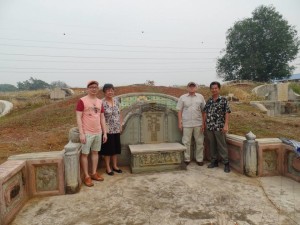
Family photo taken with the tomb-keeper. (L-R): Norman Cho, Elizabeth Cho-Tan, Peter Tan, Tomb-keeper Liow. (photo Norman Cho)
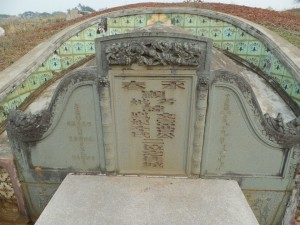
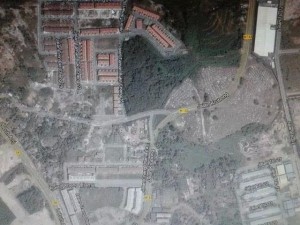
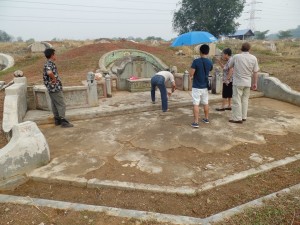
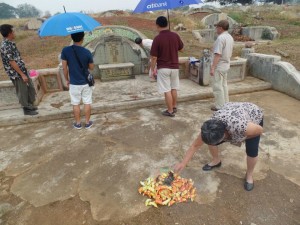
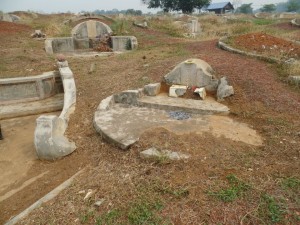

Hello Norman,
That is indeed a miracle. I am still hoping for miracle in my search for my great grandparents’ graves in Bukit Brown.
Dear Mei Jiuan,
If you know the names of your great grandparents and the year they died, you can look for them online in the Bukit Brown Registry. http://www.nas.gov.sg/BukitBrown_signage.htm
That was how Norman found his grandfather. Let us know if we can help further by dropping an email to a.t.bukitbrown@gmail.com
All the best,
Catherine
Well, I had my miracle on July 2 when we found out that 8 ancestors’ graves were exhumed last year and are now interred in the Mandai Columbarium. They were buried in the Seh Ong cemetery and not Bukit Brown. Hence they were not recorded in the Bukit Brown burial register. Apparently the Seh Ong cemetery did not keep any records of the burials.